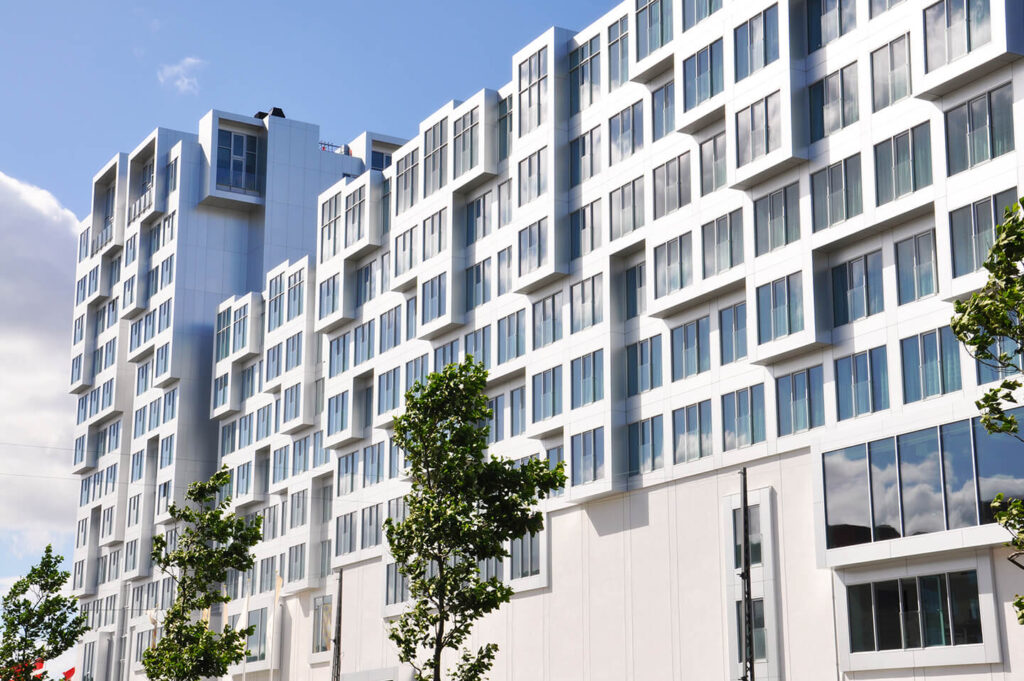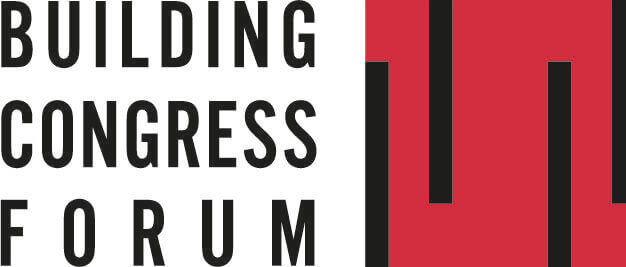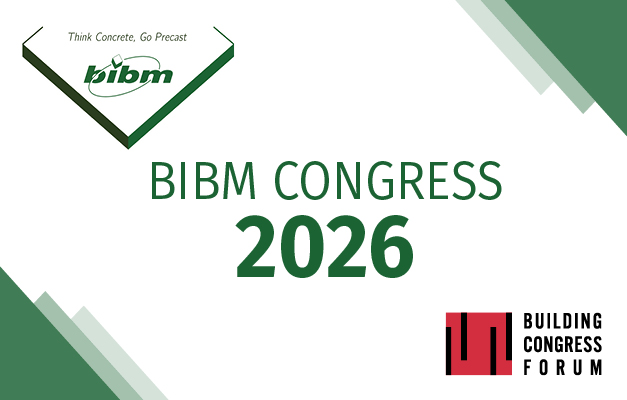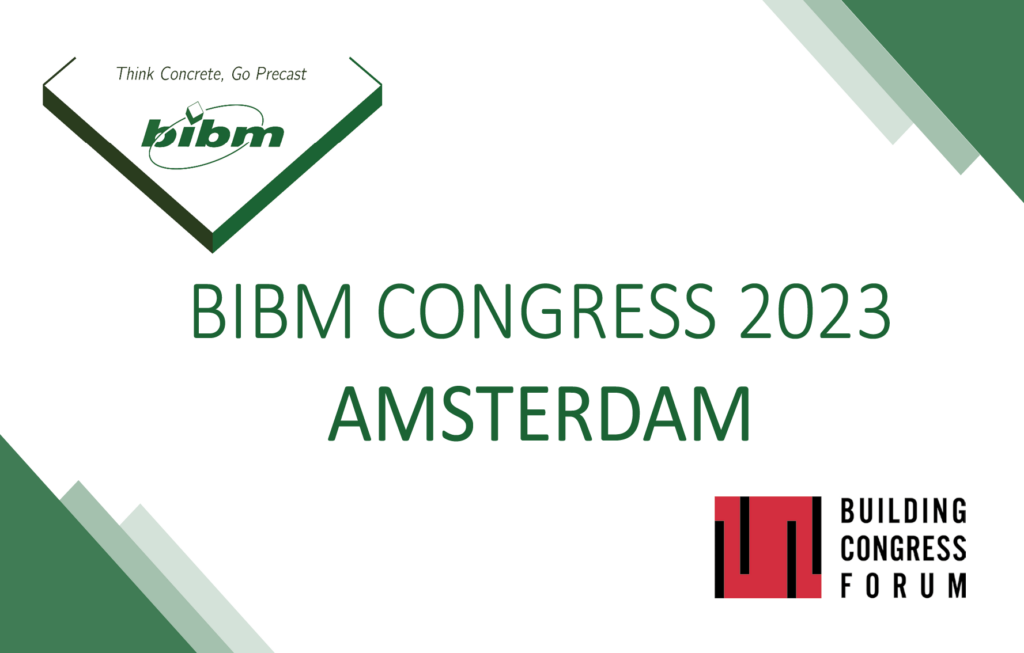BIBM CONGRESS
The 25th BIBM Congress will take place in 2026 in Italy. More info will follow soon!
The 24th BIBM Congress 2023, which took place from 27 to 29 September at the renowned Hotel Okura in Amsterdam, was a resounding success with more than 450 participants and 74 exhibitors. The Association of European Precast Concrete Manufacturers (BIBM), in collaboration with the organiser BCF – Building Congress Forum GmbH, once again invited interesting representatives from the industry to the Dutch capital, which is also known as the “Venice of the North”. Under the motto “Green | Digital | Resilient | Precast Concrete Solutions”, the congress aimed to explore and promote sustainable, technically advanced and resilient approaches in the precast concrete industry.
WORDS OF WELCOME
The congress opened on Wednesday evening, 27 September, with greetings from Bart van Melick, outgoing BIBM President and CEO of BTE Holding B.V. in the Netherlands, and Michiel Roelfsema, Managing Director of Hotel Okura Amsterdam. In addition, Philip Crampton, President of the European Construction Industry Federation (FIEC) from Ireland, presented starting points that deal in depth with the future of construction in a society in which both environmentally friendly and digital principles are important.
INTRODUCTORY EVENT
On Thursday morning, the congress opened with an introductory session, including welcome speeches by Alessio Rimoldi, Secretary General of BIBM (European Precast Concrete Industry Association) from Belgium, and Dr Ulrich Lotz and Michael Voss, Managing Directors of Building Congress Forum GmbH, Germany. In addition, Seamus McKeague, Managing Director of Creagh Concrete Products Ltd. from Northern Ireland and President of the IPHA (International Prestressed Hollowcore Association) – a partner of the BIBM Congress – gave a presentation on the IPHA, emphasising in particular the importance of joint support for the precast concrete industry.
The agenda also included presentations on various topics, such as the relationship between urban nature and health, which was addressed by Marco van Es, founder of Bac2nature from the Netherlands. In addition, Oscar Nieto, officer from the European Commission’s Directorate General GROW Department H1 – Construction, explained the European Commission’s initiatives for construction products.
GREEN – A SUSTAINABLE REVOLUTION
The construction sector has undergone a significant shift towards sustainability, driven by an increased awareness of the environmental impact of conventional methods. The series of lectures on the topic of “Green”, moderated by John-Erik Reiersen, Chairman of the BIBM Environmental Commission and Managing Director of Concrete Norway, focussed on various aspects of sustainable construction. These included topics on CO2-neutral binders, methodologies for assessing the service life of concrete and initiatives aimed at reducing CO2 emissions across the entire concrete value chain.
Dr Anja Buchwald, ASCEM Director/BTE Group from the Netherlands, gave a presentation on the development of CO2-neutral binders. The progress of the Italian precast concrete industry to fulfil the new sustainability requirements under the Green Deal was discussed by Marco Pecetti, IPHA Board Member/Managing Director of Prefabbricati, Italy, in addition to the strategic implications for manufacturing processes and improvements to end products. José Rodriguez Soalleiro, civil engineer specialising in roads, canals and ports at ANDECE (the Spanish association of the precast concrete industry), presented a methodology for assessing the service life of concrete elements.
DIGITAL – TRANSFORMATIVE TECHNOLOGIES IN THE PRECAST CONCRETE INDUSTRY
Digitalisation has become a critical issue in the construction industry, with BIM (Building Information Modelling), sensors for the Internet of Things (IoT), and Artificial Intelligence (AI) being the drivers for efficiency and sustainability. In the “Digital” lecture series, moderated by Magdalena Herbik, Communications and Public Affairs Manager at BIBM, various topics relating to the digitalisation of the construction industry were discussed. These included BIM object libraries for precast concrete elements, end-to-end BIM integration and the opportunities and challenges of digitalisation from an engineering perspective.
Rémi Lannoy, Head of Digital Construction & BIM at the CERIB Research Centre for the Concrete Industry (Centre d’études et de recherche d l’industrie du béton) in France, explained the development of a database for a BIM object library for the French precast concrete industry. From an engineering perspective, engineer Joseph Ickmans, Head of Digitalisation of the BIBM Committee at EFCA (European Federation of Consulting Associations in Engineering) in Belgium, discussed the opportunities and challenges of digitalisation. Mark Jäckel, Head of the BIM department at Goldbeck GmbH in Germany, again went into detail about the area of automated industrial construction.
RESILIENT – BUILDING FOR THE FUTURE
With a focus on resilience to natural disasters and extreme weather events, the EU emphasises the importance of construction practices that ensure durability and safety. Moderated by Taco van Broek, Chairman of the Technical Committee at BIBM and Technical Advisor to the Dutch Concrete Association, the ‘Resilience’ session of the congress explored precast concrete solutions for flood and fire protection and the load-bearing capacity of precast concrete structures to withstand unexpected loads due to seismic instability.
As part of this series of presentations, Ernesto Villalobos from Chile, CEO of Holcim Modular Solutions in Central America, based in Costa Rica, spoke on the topic of precast concrete structures in areas prone to high seismic activity. Oscar Ekefäll, development engineer at S:T Eriks from Sweden, gave an insight into concrete solutions specially tailored to flood protection. Dr Chiara Crosti, fire engineering structural design and consultancy for Italian research at Assobeton, went into detail about the results of Italian research into the fire behaviour of masonry and the joint initiatives within a group of companies associated with Assobeton.
GREENING THE VALUE CHAIN
All players in the value chain should be involved in the process of decarbonising precast concrete elements across the entire life cycle. On Friday morning, the speakers had the opportunity to present efforts towards decarbonisation in the concrete and cement industry and in the market for concrete admixtures during the “Greening the value chain” series of topics moderated by Magdalena Herbik.
Thomas Guilot, Managing Director of the UK-based Global Cement and Concrete Association (GCCA), began with an overview of the decarbonisation of the cement and concrete industry. Nihal Kinnersley, Chair of the Environmental Committee of the European Federation of Concrete Admixtures Associations (EFCA) in Belgium, discussed the role of admixtures in the decarbonisation of the concrete (precast) sector. Rob van der Meer, Director of Industrial Policy at Cembureau, the European Cement Association in Belgium, presented advances in carbon capture in the cement industry. In addition, Wietse de Jong, Rjikswaterstraat project manager for bridges and flyovers in the circular system, gave an inspiring presentation on the reuse of precast beams in the Netherlands.
FUTURE PERSPECTIVES FOR PRECAST ELEMENTS
The concluding series of topics, moderated by Kjell-Ole Gjestemoen (IPHA Managing Director), focussed on future innovations and trends in the precast concrete industry. Johann Kollegger, Professor at the Vienna University of Technology in Austria, discussed new methods for material-saving and cost-effective bridge construction with precast elements. Topi Paananen, IPHA board member and CEO of the Peikko Group in Finland, and Fernando De los Rios, CEO of Hyperion Robotics from Spain, spoke about the potential of 3D printing technology, which can realise material savings of 75% for foundations, and raised the question of whether this could be another business area for precast manufacturers. Terhi Rauhamaki, Quality and Environment Manager at Rudus Oy in Finland, presented the Rudus biodiversity programme and reported on experiences and opportunities for the precast concrete sector.
This was followed by the closing event, where the newly elected BIBM President, Stefan Van Duggenhout (Managing Director of CRH Structural Concrete, Belgium), gave an inspiring speech and spoke about the importance of looking to the future. In his speech, he invited BIBM members to join him on stage to express the sense of unity within the association.
INNOVATION IN THE SUPPLIER INDUSTRY
Advances in the supplier industry were also highlighted during the congress. Numerous participants took part in the two “Innovation Workshops”, where selected exhibitors presented their technical solutions for daily production challenges in short demonstrations. In addition, representatives from BIBM’s Brussels office – Alessio Rimoldi (Secretary General), Magdalena Herbik (Communications and Public Affairs Manager) and new colleague Ebru Akgün (Sustainability & Circular Economy Officer) – had the opportunity to present the launch of the BIBM Decarbonisation Pledge, which represents the precast industry’s contribution to a sustainable built environment.
The congress was accompanied by an exhibition with the participation of 74 companies from the global supplier, mechanical engineering and software industries. This exhibition was organised under the auspices of the congress’ main platinum sponsor, Master Builders Solutions, and silver sponsor ALLPLAN.
NETWORKING
The supporting programme for accompanying persons offered the opportunity to get to know the Dutch capital a little better and included a diamond tour and a city tour. In addition, some participants had the opportunity to take part in an origami workshop at Hotel Okura. A highlight of the social events was the gala dinner at the Rosarium in the beautifully green Amstelpark, where guests had the opportunity to socialise in a relaxed atmosphere.
The next BIBM Congress is planned for 2026, details of the venue will be announced in the coming months.
Text: Magdalena Herbik

EUROPEAN PRECAST CONCRETE INDUSTRY HELD SUCCESSFUL CONGRESS IN COPENHAGEN
With a delay of one and a half years due to corona, the 23rd BIBM Congress took place in Copenhagen from November 14 to 16, 2021. The European precast concrete association Bureau International du Béton Manufacturé (BIBM) together with the organizers of BCF – Building Congress Forum GmbH had invited to the Danish capital. Around 350 people from all over Europe attended the industry event and met at the Tivoli Congress Center under the safety and hygiene regulations in force in Denmark. The technical program focused on construction with precast elements in the Nordic countries. “The Future of European Construction – Precast Excellence in Nordic Countries” was therefore also the congress motto. In addition to best practice examples from these countries, megatrends such as digitalization, circular economy and decarbonization were on the agenda.
SECTOR IN FOCUS
Increased demand, rising prices, the scarcity of resources and stricter climate protection requirements pose enormous challenges for the construction industry, emphasized the Dutch BIBM President Bart van Melick via video in his opening speech. As the most widely used building material in the world, concrete is a particular focus of attention. In view of the many positive properties of concrete and the advantages of precast concrete elements, he nevertheless looks optimistically into the future. Even if the way there is certainly not easy, the industry has a high innovation potential and offers solutions for the future. This was also demonstrated by the contributions at the congress.
BIBM Secretary General Alessio Rimoldi and Head of Public Relations Magdalena Herbik first presented the planned measures under the “European Green Deal” and their impact on the industry. The EU Commission is aiming for a climate-neutral Europe by 2050. To achieve this, net greenhouse gas emissions are to be reduced by at least 55% by 2030 compared with 1990. In their presentation, they showed what contribution the precast concrete industry can make to achieving these climate protection targets. In doing so, they referred to the new edition of the “Little Green Book”, which compactly presents the many benefits of precast concrete and was distributed to the public for the first time at the BIBM Congress. Seamus McKeague, President of the International Prestressed Hollocore Association and Managing Director of Creagh Concrete Products Ltd, then went into some of the advantages, such as fire protection, shorter construction times or the variety of designs, and presented realized residential and commercial buildings in Great Britain and Ireland.
BEST PRACTICE FROM SCANDINAVIA AND FINLAND
Interesting impulses were provided by the examples from the Scandinavian countries and Finland. They play a pioneering role in terms of prefabrication. Architect Bo Christiansen, Scaledenmark, explained how Copenhagen is setting new standards for sustainable urban development. With design sensitivity, political foresight and green mobility, the Danish capital has set out to become a CO2-neutral metropolis as early as 2025. Making the city more livable and creating added value with its buildings is also the concern of JAJA Architects. Kathrin Susanna Gimmel presented the Lüders parking garage in the former harbor as an example. With its eight floors, it provides sufficient parking space and at the same time offers a place on the roof that invites people to play, do sports and linger. As part of the “Ressource Blokken” research project, the office is currently working on the construction of a housing estate made of precast concrete elements that were already used in the 1960s and 1970s. Supporting upcycling and becoming “precast concrete reusers” in addition to precast concrete manufacturers was therefore their call to the industry. The contribution of Finnish architect Kimmo Lintula, K2S Architects, was also forward-looking. He presented sustainable architecture made of concrete, using innovative technologies such as concrete core activation.
CIRCULAR ECONOMY WITH PRECAST CONCRETE ELEMENTS
The theme of “sustainability” ran like a thread through the program. Contributions on research projects such as SeRaMCo (Secondary Raw Materials for Concrete Precast Products) by Prof. Dr.-Ing. Christian Glock, Technical University of Kaiserslautern, or on the projects VEEP and RE4 (RE4 – REuse and REcycling of CDW materials and structures in energy efficient pREfabricated elements for building REfurbishment and construction) presented by Zuzana Tatáková, project manager at FENIX TNT, showed the potentials of precast concrete elements in terms of circular economy. For example, by optimizing the mixes for recycled concrete, new applications were also developed for load-bearing and non-load-bearing precast concrete elements. In addition, the recycling of construction and demolition waste materials as well as the use of demountable precast elements enable buildings whose components can be completely dismantled and recycled at the end of their life cycle. This can significantly reduce the amount of waste generated.
Another example of this is the “Circle House” project. It shows that circular and at the same time low-cost construction can also be realized in practice. In a newly developed residential area near Aarhus in Denmark, the world’s first social housing units built according to the principles of the circular economy were created. Kasper Guldager Jensen, co-founder Home.Earth, and Topi Paananen, Peikko Group, reported on the property and the innovative connection technology used, which enables easy deconstruction of the precast concrete elements.
WAYS TO DECARBONIZATION
Decarbonization makes a significant contribution to reducing the ecological footprint of the construction industry. In addition to new CO2-efficient raw materials for cement clinker and concrete production, the capture of CO2 in the cement plant and its utilization or storage (carbon capture and utilization/storage) play a particularly important role. Claude Loréa, Executive Director of the Global Cement and Concrete Association in Brussels, outlined the cement and concrete industry’s plan to achieve “net zero” CO2 emissions by 2050. Anne Rønning, Østfold Research Institute, and Christian John Engelsen, Research Scientist Infrastructure from Norway presented their research project on the sequestration of CO2 in concrete. For Prof. Karen Scrivener, University of Lausanne, the use of concrete is essential in view of the increasing demand for construction and the limited supply of wood. She is betting on low-clinker cements for the future, in which a significant proportion of the limestone is replaced by clays, which are considerable and whose potential has hardly been exhausted.
Communication and interaction with political decision-makers is another important aspect of the sustainability debate. One of the main tasks is to break through the often entrenched opinions about substitutes such as wood as a supposedly more “sustainable” building material in order to maintain the industry’s competitiveness. After all, these are often not based on scientific facts, but on emotions. John-Erik Reiersen, Managing Director of the Norwegian Precast Concrete Association reported on his personal and data-based approach.
USE IN ROAD CONSTRUCTION, GARDENING AND LANDSCAPING
Precast concrete elements are widely used in road construction, gardening and landscaping. In this context, Sogge Johnsen, Product Manager at Basal, informed about innovative sustainable trends in stormwater management. Stef Maas, Managing Director of the Belgian Precast Concrete Association, presented the impressive infrastructure of the Flemish cycle path network. It was expanded a few years ago to include a route through the middle of the De Weijers pond landscape in the province of Limburg. The cycle path leads from one bank to the other. You don’t get wet, because the bike path, which is built below the water level, is paved on both sides with walls made of concrete elements and thus offers a unique riding experience.
THE CHALLENGE OF DIGITIZATION
A future topic that could not be missed at the BIBM Congress: digitalization. How can the digital transformation in the construction sector succeed? Where are the challenges in implementing it in the plant? These were the questions addressed in the presentation by Christophe Sykes, General Manager of Construction Products Europe. Due to decentralized construction production, the potential is often not sufficiently exploited. In many places, the necessary transparency and communication are still lacking. One building block of digitalization is Building Information Modeling (BIM). Specialist Brian Rasmussen, Bravida Denmark A/S, reported from his practical experience and on the hurdles that have to be overcome when implementing BIM in the company. Alejandro Lopéz Vidal from the Spanish Precast Concrete Association pleaded in his contribution for the industry to deal with digitalization and its specific challenges at an early stage. New methods such as BIM and innovative technologies such as 3D concrete printing, augmented reality, etc. offered opportunities to increase efficiency in operations and secure a competitive advantage.
This was also in line with the view of Prof. Benjamin Kromoser from the University of Natural Resources and Life Sciences, Vienna (BOKU). For example, in view of the prevailing shortage of skilled workers, new digital planning and automated manufacturing methods show great potential for significantly increasing productivity. He also listed further levers for more efficient and resource-saving production in the precast concrete industry. Starting points would be the material, the structure and the production.
INNOVATIONS OF THE SUPPLIER INDUSTRY
The two “Innovation Workshop Sessions” were also very well received by the participants. Here, selected exhibitors presented their technical solutions for everyday production in compact lectures. The congress was accompanied by an exhibition featuring 73 companies from the international supplier, machinery and software industries, led by the main sponsor of the congress, Master Builders Solutions.
INTERNATIONAL NETWORKING
For the accompanying persons, the social program provided an opportunity to get to know the Danish capital a little better. A highlight for everyone was the evening event in the historic Langelinie Pavilion. The generously dimensioned listed building from the 1950s not only provided a magnificent view over the skyline and the harbor of Copenhagen, but with its ambience in the mid-century style of Danish interior design also offered a worthy setting to bring the first day of the congress to a comfortable close.
To educate oneself further without restrictions, to talk with colleagues and market partners and to talk shop – for a few days one felt transported back to “normal” times at the BIBM Congress. A state that will hopefully be possible again for everyone and everywhere in the foreseeable future.
The next BIBM Congress will take place in 2023. The location will be announced in spring 2022.


